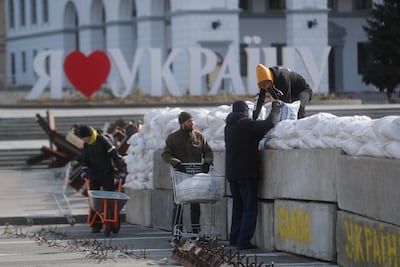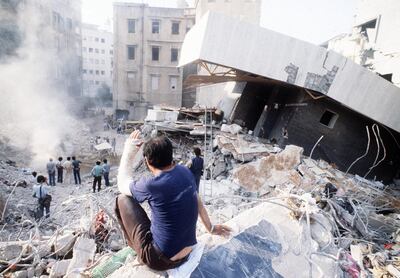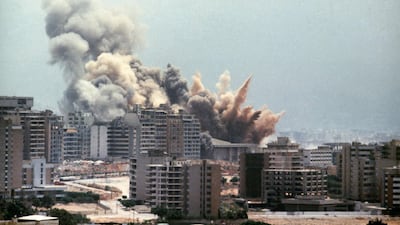As Russian forces start surrounding the Ukrainian capital Kyiv, people are questioning whether this will lead to a siege of the city. Forty years ago, in the summer of 1982, Israel besieged West Beirut to force Palestinian armed groups to depart from Lebanon. The lessons from that battle may provide Ukrainians with some clarity with respect to what lies ahead.
A siege of Kyiv would pose many problems for the Russians. It could take valuable time, at a moment when Russian President Vladimir Putin seeks to quickly impose his political conditions on the Ukrainians, before Russia feels the full economic impact of sanctions. At the same time, slow progress or failure in Kyiv could stiffen resistance in other parts of Ukraine.
In this regard, Mr Putin is at a disadvantage compared to the Israelis in 1982, whose siege lasted for over three months. They had factored a longer timeframe into their aims – of using the siege of West Beirut to force the Palestinian leadership out of Lebanon, and to install an ally as Lebanon's president. Moreover, Israel conquered most of southern Lebanon up to Beirut in just one week. Russia is not in a similar situation.
The question is whether the Ukrainians will be able to force the Russians into a siege, intentionally or unintentionally. If the Russians try to enter Kyiv and find resistance too strong, Mr Putin will be left with one of two choices: to pursue the ground offensive, sending his men into a politically costly bloodbath; or pulling back to the outskirts of the city and continuing bombing.
As the Israelis knew well, military superiority has a relatively limited impact against well-organised defenders. They besieged West Beirut for three months, cutting off water, electricity and fresh food. Their air domination notwithstanding, when they tried to enter the city they met ferocious resistance and had to pull back.
I lived through the siege of Beirut and will not forget it
Nor is relentless bombardment a solution to this. While it may demoralise the inhabitants of a city for a time, it also creates many more obstacles for an invading army. Bombing encumbers roads with rubble, hindering tanks and producing infinite new defensive positions for those in the city.
Mr Putin may face another problem. If Ukrainian President Volodymyr Zelenskyy remains in Kyiv, securing the political benefits that result from taking the capital would come to mean less than what happens to Mr Zelenskyy himself. This may narrow the Russians’ margin of manoeuvre, in that the Ukrainian president’s political survival could be seen as Mr Putin’s loss.
In West Beirut, the exit of the Palestinian leadership was a central aim of Israel. Mr Zelenskyy’s downfall was certainly a Russian priority when the invasion of Ukraine began, but today that appears to be less certain. If Mr Putin’s core objective is to bring Ukraine back in to Russia’s sphere of influence – and Mr Zelensky is willing to discuss this – then making the siege of Kyiv all about the fate of the Ukrainian president may detract from that aim and mean that Mr Zelenskyy comes out looking like a victor even if he makes concessions. That's precisely what happened to the Palestinian leader Yasser Arafat. While his exit from Lebanon represented a major defeat, the fact that he had survived politically allowed him to portray the Palestinian resistance in West Beirut as a triumph.
Then there is the symbolism. Sieges favour the besiegers, but in terms of public perceptions they reinforce the besieged, making them appear heroic. The courageous defiance of cities such as Leningrad (St Petersburg), Sarajevo and Gaza resonate to this day. If Mr Putin wants to draw Ukraine back in to the Russian fold, then inadvertently highlighting the valiant nature of Kyiv’s defenders may well have the opposite effect.
This can also have repercussions on the attitude adopted by Russia’s allies. The longer and bloodier is a siege of Kyiv, the more will Russia’s allies, notably China, have doubts about supporting its actions. This could limit Russia's political options.
That is precisely what happened in 1982. Initially, the Reagan administration was willing to cut the Israelis slack to get rid of the Palestinians. But when it sent its mediator Philip Habib to Lebanon, things changed. As civilian casualties mounted, and Washington was partly blamed, tensions rose between the Americans and Israelis.
Yet Israel had an advantage, in that the Sunni Muslim leadership in West Beirut openly opposed seeing their half of the city destroyed on the Palestinians’ behalf. Mr Zelenskyy faces no such difficulties. There is little pressure inside Kyiv that can help Russia.
I lived through the siege of Beirut and will not forget it. It is a matter of pride for me that I survived and put up with the hardships it imposed. I wouldn’t want to go through such a trial again but out of defiance I could if I had to. Reactions similar to mine are likely not the kind that Mr Putin sought to provoke when Russia invaded Ukraine.
As the Israelis neared West Beirut in 1982, one of the Palestinian leaders, George Habash, said he would transform the city into “a new Stalingrad”. Ultimately, it wasn’t quite that, but as Russian forces advance on Kyiv, Mr Putin may find that his country’s own history, ironically, provides his enemies with inspiring guidelines to fight the Russian attack.
The specs
Engine: 4.0-litre V8 twin-turbocharged and three electric motors
Power: Combined output 920hp
Torque: 730Nm at 4,000-7,000rpm
Transmission: 8-speed dual-clutch automatic
Fuel consumption: 11.2L/100km
On sale: Now, deliveries expected later in 2025
Price: expected to start at Dh1,432,000
UAE currency: the story behind the money in your pockets
KINGDOM%20OF%20THE%20PLANET%20OF%20THE%20APES
%3Cp%3E%3Cstrong%3EDirector%3A%3C%2Fstrong%3E%20Wes%20Ball%3C%2Fp%3E%0A%3Cp%3E%3Cstrong%3EStarring%3A%3C%2Fstrong%3E%20Owen%20Teague%2C%20Freya%20Allen%2C%20Kevin%20Durand%3C%2Fp%3E%0A%3Cp%3E%3Cstrong%3ERating%3A%20%3C%2Fstrong%3E3.5%2F5%3C%2Fp%3E%0A
The specs
- Engine: 3.9-litre twin-turbo V8
- Power: 640hp
- Torque: 760nm
- On sale: 2026
- Price: Not announced yet
The%20specs
%3Cp%3E%3Cstrong%3EPowertrain%3A%20%3C%2Fstrong%3ESingle%20electric%20motor%0D%3Cbr%3E%3Cstrong%3EPower%3A%20%3C%2Fstrong%3E201hp%0D%3Cbr%3E%3Cstrong%3ETorque%3A%20%3C%2Fstrong%3E310Nm%0D%3Cbr%3E%3Cstrong%3ETransmission%3A%20%3C%2Fstrong%3ESingle-speed%20auto%0D%3Cbr%3E%3Cstrong%3EBattery%3A%20%3C%2Fstrong%3E53kWh%20lithium-ion%20battery%20pack%20(GS%20base%20model)%3B%2070kWh%20battery%20pack%20(GF)%0D%3Cbr%3E%3Cstrong%3ETouring%20range%3A%20%3C%2Fstrong%3E350km%20(GS)%3B%20480km%20(GF)%0D%3Cbr%3E%3Cstrong%3EPrice%3A%20%3C%2Fstrong%3EFrom%20Dh129%2C900%20(GS)%3B%20Dh149%2C000%20(GF)%0D%3Cbr%3E%3Cstrong%3EOn%20sale%3A%3C%2Fstrong%3E%20Now%3C%2Fp%3E%0A
Saudi Cup race day
Schedule in UAE time
5pm: Mohamed Yousuf Naghi Motors Cup (Turf), 5.35pm: 1351 Cup (T), 6.10pm: Longines Turf Handicap (T), 6.45pm: Obaiya Arabian Classic for Purebred Arabians (Dirt), 7.30pm: Jockey Club Handicap (D), 8.10pm: Samba Saudi Derby (D), 8.50pm: Saudia Sprint (D), 9.40pm: Saudi Cup (D)
COMPANY%20PROFILE
%3Cp%3E%3Cstrong%3EName%3A%3C%2Fstrong%3E%20Carzaty%2C%20now%20Kavak%3Cbr%3E%3Cstrong%3EBased%3A%3C%2Fstrong%3E%20Dubai%3Cbr%3E%3Cstrong%3ELaunch%20year%3A%20%3C%2Fstrong%3ECarzaty%20launched%20in%202018%2C%20Kavak%20in%20the%20GCC%20launched%20in%202022%3Cbr%3E%3Cstrong%3ENumber%20of%20employees%3A%3C%2Fstrong%3E%20140%3Cbr%3E%3Cstrong%3ESector%3A%3C%2Fstrong%3E%20Automotive%3Cbr%3E%3Cstrong%3EFunding%3A%20%3C%2Fstrong%3ECarzaty%20raised%20%246m%20in%20equity%20and%20%244m%20in%20debt%3B%20Kavak%20plans%20%24130m%20investment%20in%20the%20GCC%3C%2Fp%3E%0A
Benefits of first-time home buyers' scheme
- Priority access to new homes from participating developers
- Discounts on sales price of off-plan units
- Flexible payment plans from developers
- Mortgages with better interest rates, faster approval times and reduced fees
- DLD registration fee can be paid through banks or credit cards at zero interest rates
The specs
AT4 Ultimate, as tested
Engine: 6.2-litre V8
Power: 420hp
Torque: 623Nm
Transmission: 10-speed automatic
Price: From Dh330,800 (Elevation: Dh236,400; AT4: Dh286,800; Denali: Dh345,800)
On sale: Now
Volvo ES90 Specs
Engine: Electric single motor (96kW), twin motor (106kW) and twin motor performance (106kW)
Power: 333hp, 449hp, 680hp
Torque: 480Nm, 670Nm, 870Nm
On sale: Later in 2025 or early 2026, depending on region
Price: Exact regional pricing TBA
UAE currency: the story behind the money in your pockets
More coverage from the Future Forum
Why are asylum seekers being housed in hotels?
The number of asylum applications in the UK has reached a new record high, driven by those illegally entering the country in small boats crossing the English Channel.
A total of 111,084 people applied for asylum in the UK in the year to June 2025, the highest number for any 12-month period since current records began in 2001.
Asylum seekers and their families can be housed in temporary accommodation while their claim is assessed.
The Home Office provides the accommodation, meaning asylum seekers cannot choose where they live.
When there is not enough housing, the Home Office can move people to hotels or large sites like former military bases.
Killing of Qassem Suleimani
Pharaoh's curse
British aristocrat Lord Carnarvon, who funded the expedition to find the Tutankhamun tomb, died in a Cairo hotel four months after the crypt was opened.
He had been in poor health for many years after a car crash, and a mosquito bite made worse by a shaving cut led to blood poisoning and pneumonia.
Reports at the time said Lord Carnarvon suffered from “pain as the inflammation affected the nasal passages and eyes”.
Decades later, scientists contended he had died of aspergillosis after inhaling spores of the fungus aspergillus in the tomb, which can lie dormant for months. The fact several others who entered were also found dead withiin a short time led to the myth of the curse.
Company%20profile%20
%3Cp%3E%3Cstrong%3EName%3A%20%3C%2Fstrong%3EYodawy%3Cbr%3E%3Cstrong%3EBased%3A%3C%2Fstrong%3E%20Egypt%3Cbr%3E%3Cstrong%3EFounders%3A%20%3C%2Fstrong%3EKarim%20Khashaba%2C%20Sherief%20El-Feky%20and%20Yasser%20AbdelGawad%3Cstrong%3E%3Cbr%3ESector%3A%20%3C%2Fstrong%3EHealthTech%3Cbr%3E%3Cstrong%3ETotal%20funding%3A%20%3C%2Fstrong%3E%2424.5%20million%3Cbr%3E%3Cstrong%3EInvestors%3A%20%3C%2Fstrong%3EAlgebra%20Ventures%2C%20Global%20Ventures%2C%20MEVP%20and%20Delivery%20Hero%20Ventures%2C%20among%20others%3Cstrong%3E%3Cbr%3ENumber%20of%20employees%3A%3C%2Fstrong%3E%20500%3Cbr%3E%3C%2Fp%3E%0A
More from Neighbourhood Watch
Secret Nation: The Hidden Armenians of Turkey
Avedis Hadjian, (IB Tauris)
More from Neighbourhood Watch:





